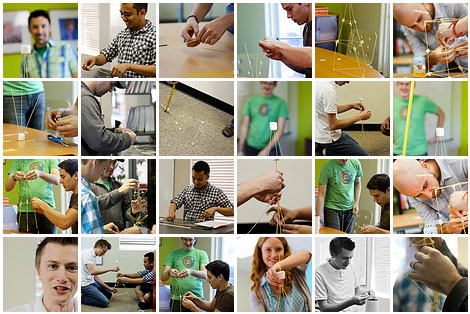Ever watch a child build a sandcastle at the beach, or a group of kids tackle a pile of LEGOs only to create an entire city in less than an hour? Children are born with an innate ability to design things out of thin air. What happens by the time we reach adulthood? Where does all that talent go?
The good news is, it's still there and with the right coaxing, our inner designer is ready to leap out. Take a look at The Marshmallow Challenge, a clever exercise dreamed up by Peter Skillman and popularized by Tom Wujec, a creative thinker in the tech industry.
The task is simple: in eighteen minutes, teams must build the tallest free-standing structure out of 20 sticks of spaghetti, one yard of tape, one yard of string, and one marshmallow. The marshmallow needs to be on top.
By drawing on some techniques we learned as kids, Wujec says we can learn some important lessons on innovation, creativity, and collaboration.
When it comes down to designing great products and services, three things emerge from the Marshmallow Challenge:
- Teams can create shared experiences by working together without worrying about pecking order. Kindergartners don't spend a lot of time trying to create power structures, they just dive right in and get to work. Good ideas naturally rise to the top like cream.
- Since the underlying hierarchy is flat, most children in a group problem-solving setting will communicate with just about everyone around them, not just a specific two or three kids. As a result, a common language emerges within the group and everyone understands each other.
- Children jump in and start experimenting with a solution right away, they don't waste time creating different prototypes of concepts that use up their materials. When teams stop over-planning, work gets done quicker and solutions emerge almost naturally.
ZURB Gives it a Go
- Teams unaccustomed to working together had a harder time making small decisions together
- Individuals spent time experimenting with their own versions
- Many didn't start with a marshmallow on top
- Left the marshmallow for the end
What gave us some success?
- Teams that had worked together before, clicked. They focused on the work, not their own ideas.
- Started with the marshmallow on top (literally succeeding with the final goal from the beginning).
- Built one version from the ground up, adjusting the details together
- Employed a few simple structural techniques, repeated them
- Conserved resources

Bryan Zmijewski
Leading the charge at ZURB since 1998
Our fearless leader has been driving progressive design at ZURB since 1998. That makes him quite the instigator around the offices, consistently challenging both the team and our customers to strive to always do better and better.
Learn more →
Follow him at @bryanzmijewski
